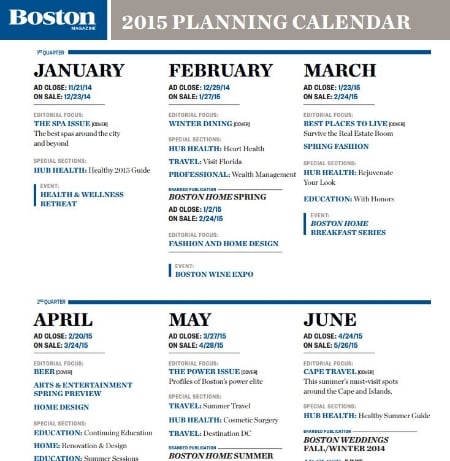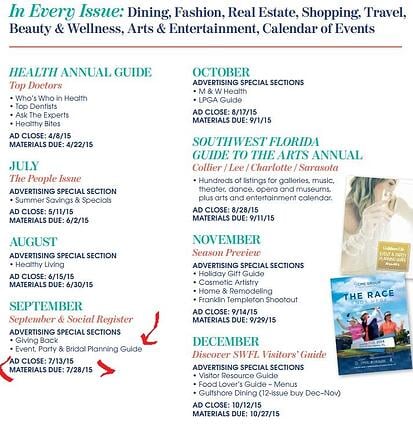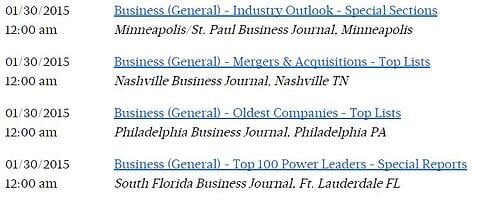What are editorial calendars and how to use them to get earned media coverage?
By Wendy Bulawa AgudeloFebruary 2, 2015
This underutilized PR asset could give you the boost you need.
Since most businesses are acutely attuned to fast-paced digital news derivatives and television, many don’t consider that a simple editorial calendar could lead to a magazine cover story. That’s where they’re mistaken.
Editorial calendars are a tool used predominantly by a print or digital publication’s advertising department to plan out significant features, focuses, or areas of interest throughout the year. Using that guide, advertising sales teams approach businesses about purchasing ad space, since most companies will advertise in issues that focus on a topic or feature critical to their primary demographics or industries.
Toward the end of every calendar year, publications begin to post their editorial calendars. Savvy public relations veterans use these tools to map the types of stories or businesses a publication plans to cover. They can then determine appropriate editions for which to pitch their clients.
For example, check out Boston Magazine's planning calendar. You’ll note a focus in May on summer travel. Now, if you own a unique resort retreat, rent summer property, or manufacture items helpful to travelers, you may want to contact the editorial team to determine its focus and potentially pitch them a story about yourself.

Step 1: Create your own customized editorial calendar.
First, you’ll want to research and put together an editorial calendar specific to your business or industry. There are a few simple methods of obtaining a copy of an editorial calendar:
-
Check the publication’s website; look in the advertising section if “editorial calendar” isn’t explicitly listed.
-
Download media kits – Each media kit contains a planning calendar.
-
As a last resort, you can contact an advertising rep and request a copy mailed or emailed.
Because publications prepare this look-ahead calendar toward the end of a calendar year, it’s helpful to begin researching and preparing your calendar for the following year in December or January. By then, most publications have outlined main feature topics, and advertising departments are looking to sell ad space to cover the cost of magazine production.
Once you’ve created your calendar, review closing dates. The closing date is when all ads must be purchased and submitted. While it’s not the same as an editorial/news deadline, a closing date indicates when writers must complete their stories. Sometimes, depending on the publication, that might be the date that the articles are edited.
When contacting monthly publications, you’ll want to give the editorial staff at least 12 weeks before the closing date, if not sooner.
For weekly publications, plan to make contact at least four weeks before close. Because it’s common for editors to assign larger feature stories up to three and four months in advance, a good rule of thumb is to make initial contact 90-180 days before an editorial close date.

If this all strikes you as complicated, you can hire a subscription-based service to scour editorial calendar opportunities specific to your industry. The costs may be prohibitive to smaller businesses, however, so a little DIY is usually worth the time investment.
Step 2: Prepare pitches, articles, tips, or to-dos and send them promptly.
Once you’ve earmarked an appropriate magazine and topic of interest, consider calling or emailing the editor or editorial assistant to find the best contact for the particular topic and issue focus. Then, it’s time to present your best pitch.
An optimal pitch contains a clear and relevant connection to the editorial topic and a compelling few lines about how your organization/service can help improve the content. It's not about your organization. It's about adding value and helping the audience. There's also no need for lengthy notes or testimonials. Just a short and simple example of how your insights and expertise can improve or bring a fresh lens to the relevant topic.
For example, your desired editorial calendar may include wedding-focused issues if you're a florist. In each instance, submit samples of one or two of your most unique wedding displays or, perhaps, tips for brides on how to make the most of a wedding flower budget. Even advice on the best flowers for a particular wedding style would be helpful to a publication looking for something unique and fresh.
Be sure to follow up at least once if you don’t hear back since reporters can get buried by emails or pitches and may need a well-timed reminder.
Step 3: Keep your editorial calendar updated.
It’s a good idea to review your editorial calendar at least once a week to make sure you don’t miss any deadline opportunities. Be aware that editorials can change and that your organization/product/service may not be a perfect fit for a publication's focus during a particular month. Even if that’s the case, you’ve taken the step to introduce yourself.
Finally, look for unique “list” or “special section” opportunities. Many monthly, quarterly, and semi-annual print magazines – especially business journals – publish special lists (e.g. Best Florists in Atlanta) or awards. Most publications have accessible online forms you can complete to submit your business for these opportunities. (Note: Once your company has earned a position on a list, reprints make a credible addition to any marketing package and future public relations efforts.)


Tackling public relations can seem intimidating, but armed with widely available information like editorial calendars, any business can take steps toward building its brand and reputation. For those prepared to move beyond these initial tactics, we encourage you to consult with the team at Axia Public Relations. We’re confident we can take your business to the next level. Call us today at 888-PR-FIRM-8.
Wendy Bulawa Agudelo has more than 15 years of experience in technology, business, consumer, and non-profit public relations. In addition to running her own business and serving on the Massachusetts Down Syndrome Congress PR Task Force, Wendy enjoys cooking and rooting for her favorite New England teams.
Topics: public relations


Comment on This Article